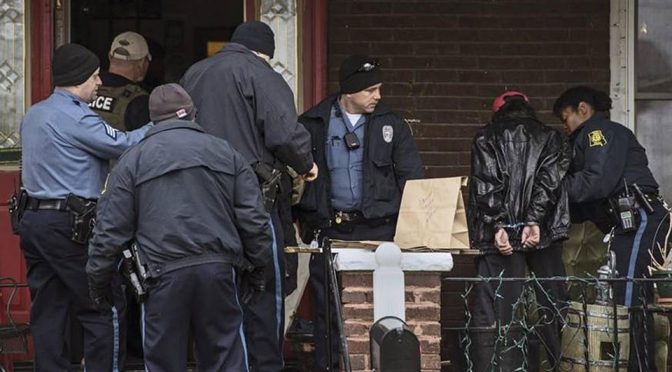When thinking of research, criminology and criminal justice may not be fields that normally come to mind. But for two UMKC faculty members, analyzing crime data is research that can save lives.
From 2010 through 2013, Kansas City ranked among the worst of the 50 largest cities in the U.S. for homicides, averaging more than 100 per year — a rate of 22 per 100,000 residents. This was two to four times greater than the national average.
Wanting to reduce violent crime, Kansas City leaders looked at programs in cities of similar size. They found positive results with focused deterrence programs in Boston and Cincinnati and liked what they learned, so they moved forward with a plan to implement a focused deterrence program in Kansas City.
With local agencies on board, only one more piece was needed — the researchers. Jackson County Prosecutor and UMKC Alumna Jean Peters Baker looked to UMKC, the only urban-based research university in the region. She approached Kenneth Novak, chair of the UMKC Criminal Justice and Criminology Department, with the idea.
“She was motivated,” Novak says. “So was the police chief and the mayor. The research project chose us.”
Not long after, Andrew Fox joined the UMKC Department of Criminal Justice and Criminology as a professor. He had experience with social network analysis — a research tool that is important for implementing focused deterrence. Novak and Fox became the researchers behind the Kansas City No Violence Alliance (KC NoVA).
The program is a multi-agency, collaborative effort to reduce gun-related violence, particularly homicides and aggravated assaults, in Kansas City’s urban core. The premise involves enforcement, social services and community leaders. They communicate messages of violence prevention to people at the highest risk of committing or being a victim of gun violence.
In the early stages of KC NoVA, Novak and Fox helped police use their own official data to track reported incidents of homicide and aggravated assaults with a gun. That data is used as they conduct audits of violent criminals, map social network connections and use those connections to encourage criminals to police themselves. Law enforcement can intervene and offer social service referrals.
Most of Kansas City’s violent crimes are not random, Novak says. Their research identifies potential groups using street-level intelligence and analysis. Police crime analysts, faculty and students analyze data to find those most likely to commit violent crimes.
Law enforcement officials can communicate with current offenders, letting them know future violence would have serious consequences. At the same time, social service agencies provide resource opportunities to avoid violence. This gives potential offenders good reasons to cooperate with the efforts to reduce violent crime.
Novak says this is a “teach a man to fish” concept. Novak and Fox don’t make decisions; instead, they serve as advisors. But they have a seat at the table and make real-time recommendations as they quickly share data with KCPD. Open communication, trust and transparency have been key to the success.
“It’s like research without a net at times,” Novak says. “We can take what we know and learn to help guide policies and approaches. The research evidence is used to inform and decide what is done.”
For example, Fox says different strategies are used for identifying high-risk offenders. The strategies are chosen based on data collected. Novak and Fox call it “action research.” They already know the level of violence is high in Kansas City. Fox says many people at high risk of committing a crime carry guns for protection. He says the goal is to develop a system to stop retaliation.
The first full year of KC NoVA implementation, 2014, saw the lowest homicide rate in KC since 1972. But 2015 saw another rise in violent crime.
“There’s so much more that can be done to address the violence in Kansas City,” Fox says. “This is one strategy that has worked.”
Fox also trained police intelligence officers to do their own analysis and mapping. They help KCPD crime analysts conduct social network analysis in order to identify violent offender groups.
An added benefit to the KC NoVA project has been training of new professionals to work in the system. Over the past three years, UMKC students have helped with different aspects of KC NoVA, including implementation and evaluation.
“Students have been helpful,” Novak says. “The good ones are getting hired by agencies participating in KC NoVA.”
He says it has been great real-world exposure for students.
“Being involved in research as a student was of tremendous benefit to me both academically and professionally,” says Nisha Stephen, information and data analyst for the Jackson County Prosecutor’s Office. “In my current job, I continue to access skills that I learned with Dr. Fox when it comes to working with data sets, identifying issues with the data and conducting analyses.”
The research being conducted by Novak and Fox is unique, but not unheard of. Traditionally, criminal justice agencies do not have a lot of internal research and development, Novak says. Therefore, UMKC research is in a position to provide an important role in addressing and solving important problems, such as violence in Kansas City.
“The research is real,” Novak says. “But it’s messy. There’s no clear beginning, middle and end.”
And the work is ongoing.
“We want to help them do the best possible job,” Fox says.



